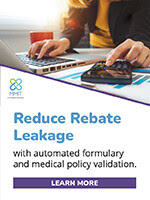Today’s guest post comes from Saket Patel, Consultant, Advisory Services at MMIT.
Saket discusses market access and contracting strategies for medical benefit products when pharmacy benefit biosimilar therapies launch. He then describes how to automate formulary and medical policies to protect manufacturers from overpayment.
Click here to learn about MMIT’s Contract Validation solution.
Read on for Saket’s insights.
The Evolution of Medical Benefit Contracting: How Pharma Can Prepare
By Saket Patel, Consultant, Advisory Services, MMIT
Given the growth of specialty pharmaceuticals, manufacturers will need to develop more aggressive contracting strategies to secure optimal market access for their medical benefit drugs. Shifting market dynamics, driven in part by the influx of lower cost biosimilars on the pharmacy benefit, will require pharma companies to focus more on rebating and cost minimization.
UNDERSTANDING MARKET FORCES
Under the tiered design of a PBM, drugs covered under the medical benefit are directly impacted by competitive activity within the pharmacy benefit landscape. As an example, the entry of immunosuppressive biosimilars led many payers to adopt step therapy restrictions for medical benefit mainstays. In many cases, before a patient can begin a regimen with a brand-name drug like Remicade, they must first step through treatment on one of the infliximab biosimilars managed under the pharmacy benefit. Manufacturers must compete not only against new products, but also against the payer’s preferences for managing costs via formulary.
This year, the wave of adalimumab biosimilars will necessitate more complex contracting strategies, especially in competitive spaces like immunology. As biosimilar manufacturers face a huge barrier to market entry, they will need to incentivize payers across all lives to gain market share. They will offer either low initial price points or significant rebating to bring their average wholesale acquisition cost (WAC) into parity with brand-name drugs. Meanwhile, manufacturers of brand-name originators will be forced to offer much larger price concessions—rebates in the range of 45% to 55%—to maintain market access.
PRIORITIZING PATHWAY INCLUSION
As vertical integration has accelerated, many IDNs have developed their own specialty pharmacies to serve as distribution centers for their clinics. IDNs now have negotiation leverage with payers based on the number of patients they treat across a given area. Some IDNs have adopted treatment pathways and formularies that restrict physicians to covered drugs, while others rely on national guidelines to dictate the regimens chosen by their providers. These IDN formularies and pathways can have a significant impact on a drug’s utilization.
To control costs, many IDNs are also developing clinical pathways for non-oncology therapeutic areas with high utilization of expensive therapies. To achieve optimal market access, manufacturers will need to meet with key influencers at these IDNs to convince them of the relative benefits of their product and secure inclusion on leading clinical pathways.
SPECIFYING FINANCIAL VALUE
Pharma companies have traditionally been reluctant to enter contract negotiations with smaller payers. With the rise of more targeted regimens, however—including CAR T-cell therapies and gene therapies in the non-oncology rare disease space—manufacturers will need to begin negotiating with both small and large payers.
Every patient matters, especially in this era of personalized medicine. As manufacturers of targeted medicines are dependent upon identifying eligible patients with specific testing values or disease states, they will need to develop an array of pricing and discounting strategies to use with payers.
In coverage discussions, pharma companies tend to focus on their product’s clinical value propositions: the safety profile and efficacy. Manufacturers should also invest time in quantifying relative values, such as the degree of symptom relief relative to the administration dose, or the product’s prolonged efficacy as compared to competitors. For complex regimens, gene therapies and high-cost combination therapies, determining the financial value of managing a patient’s disease state over the long term is critical.
LEVERAGING CREATIVE CONTRACTING
When coverage conversations turn into contract negotiations, pharma companies can use their product’s established value to give assurances to payers in the form of warranty programs and other value-based initiatives. For example, if a patient must discontinue a regimen within a certain period, the manufacturer might promise the payer a discontinuation credit.
Value-based contracting, especially for gene therapies that are purportedly curative, will help provide payers the financial guarantees they need to offer long-term coverage. Currently, the terms of value-based agreements are typically more favorable for the manufacturer than the payer. As high-cost gene therapies enter the market, payers will seek to negotiate more balanced terms. Given the unknown downstream implications of these therapies, payers are likely to employ strict policies and coverage reviews for each patient.
For most therapies, however, negotiations will center around securing preferred placement. In exchange for a percentage discount off the WAC, manufactures can ask for concessions like the removal of step therapy restrictions or the designation of preferred status. After contracting is complete, manufacturers will also need to guard against rebate leakage by crosschecking the execution of contract requirements with payers and PBMs.
Regardless of the contracting approach they choose, manufacturers of medical benefit products will need to carefully plan their market access strategy to ensure favorable product positioning relative to their competitors.
Ready to ensure the accuracy of your rebate payments? MMIT’s Contract Validation solution automates the formulary and medical policy validation process to protect manufacturers from overpayment.
Sponsored guest posts are bylined articles that are screened by Drug Channels to ensure a topical relevance to our exclusive audience. These posts do not necessarily reflect our opinions and should not be considered endorsements. To find out how you can publish a guest post on Drug Channels, please contact Paula Fein (paula@DrugChannels.net).



No comments:
Post a Comment